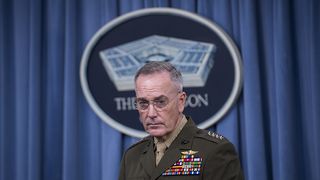Joseph Dunford, the chairman of the US Joint Chiefs of Staff, made a remarkable admission last month: “Without sustained, sufficient, and predictable funding, I assess that within five years we will lose our ability to project power; the basis of how we defend the homeland, advance US interests and meet our alliance commitments.”
General Dunford was speaking bluntly about congress’s cuts to military spending and failure to provide funding certainty for the past eight years. This has evolved into a crisis, with direct impacts on the US military’s operations and ability to project force.

Dunford’s reference to alliance commitments should pique interest in Canberra. Australia’s defence strategy relies on the deterrence and certainty provided by US power projection across the Indo-Pacific.
If the deadlock in congress continues, the Pentagon will be forced to cut back on technological investments and shrink the scale and scope of its various deployments. Competitors may also be emboldened to take risks, believing the US is unable to sustain the global, not just regional, security role it plays now.
This budget crisis stems directly from a failed political bargain in 2011, under which a polarised congress was supposed to come together to raise the debt ceiling. The bargain failed and “sequestration” came into effect with roughly $1.2 trillion in spending cuts over a decade divided evenly between military and non-military expenditure. The impact has been acute. In 2013, the first year of sequestration, the Pentagon endured the largest single-year percentage budget cut since the end of the Korean War.
Defense Secretary James Mattis attributed more blame for the state of the US military to congress than unrelenting and increasingly truculent behaviour by China, Russia, Iran and other powers.
Defense Secretary James Mattis said earlier this year that “no enemy in the field has done more to harm the combat readiness of our military than sequestration”. That is a noteworthy statement — Mattis attributed more blame for the state of the US military to congress than unrelenting and increasingly truculent behaviour by China, Russia, Iran and other powers.
Meanwhile, the Pentagon faces a difficult predicament as it tries to invest in technologies and capabilities that will allow it to maintain its advantage over competitors, while simultaneously ensuring the maintenance of its existing military forces.
It’s a difficult balance to pull off in the best of times. But in the past few years these factors have compounded, with serious consequences for the ability of the US Armed Services to conduct training, stock suitable levels of munitions, maintain equipment and prepare for a significant conflict or contingency.
The backlog of maintenance, infrastructure and facilities sustainment across the US military runs in the tens of billions of dollars. In his recent testimony, General Dunford said that the US Air Force is short 1500 pilots, half of them combat roles, as well as 3400 maintenance specialists. The current Chief of Staff of the Air Force stated that only half the US Air Force is at “full-spectrum readiness”; it would need 80 per cent in the event of a major confrontation.
Despite the Pentagon raising the alarm and even blaming congress for shrinking US advantage over potential adversaries, there are few indications that congress will overcome its bitter partisanship and pass a budget that would satisfy the Pentagon.
The other armed services are in similar situations. A 2016 Marine Corps assessment stated that only “43 per cent of the corps total aircraft inventory is currently considered flyable” leaving it unable to “meet wartime commitments”. Two-thirds of the US Navy’s F/A18s are grounded waiting for spare parts. The average time at sea for a US Carrier Strike Group has ballooned to nine months, straining crews and maintenance cycles.
Despite the Pentagon raising the alarm and even blaming congress for shrinking US advantage over potential adversaries, there are few indications that congress will overcome its bitter partisanship and pass a budget that would satisfy the Pentagon.
Most Republicans and some Democrats are in favour of increased military spending. But the right-wing House Freedom Caucus, which numbers more than 30, opposes increases in defence spending that would push up the budget deficit.
Most Democrats want to extract a price for any vote to increase defence spending, such as commensurate spending on healthcare and social security.
The broader issue in congress is that legislators have little political incentive to appropriate the funds required to restore the readiness of the US military. Members of congress like supporting new weapons or shipbuilding projects that create jobs in their states and districts, but are less fond of telling constituents they have helped reverse maintenance issues with existing military equipment.
The superpower status of the United States partly rests on the assumption that it has the capability to fight two major confrontations at once. But the uncertain and unfavourable budgetary situation is seriously calling this into question.
Allies like Australia cannot escape the consequences of this broader budgetary and readiness deadlock.
The US maintains the largest defence budget in the world by a fair margin. It is unique in its global superpower status, with a military that spans the globe, charged with deterring not only smaller regional powers such as Iran and North Korea, but also significant geopolitical competitors such as China and Russia.
Its superpower status also partly rests on the assumption that it has the capability to fight two major confrontations at once. But the uncertain and unfavourable budgetary situation is seriously calling this into question.
Regular training and good equipment provide the President with more options and confidence in a crisis. The more this “capabilities gap” between the US and its competitors shrinks, as Dunford has stated, the more casualties the US “will have to endure to accomplish a given mission”.
Developments on Capitol Hill and decisions in the Pentagon will be vitally important to the nature of global order and the military balance in Asia. So long as the congressional infighting continues, the Pentagon’s leaders will face increasingly tough choices regarding the balance over modernisation, training, the forward deployment of its forces and even the price it is willing to pay in any given scenario.
Australia should be paying attention.







